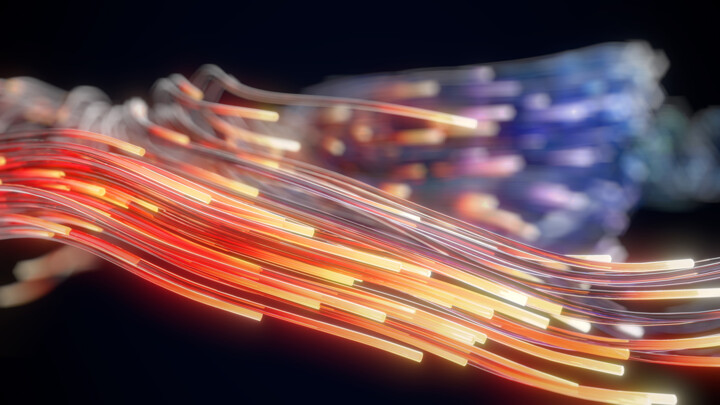A Sustainable Future with Optical Fiber
Corning and Sphera unlock the green potential of optical fiber; how its low carbon footprint revolutionizes connectivity. Discover its environmental edge over copper networks and the sustainable path forward.

©kasezo | istockphoto.com
Optical fiber is at the heart of our modern connected world, transmitting massive amounts of data daily. Today’s connections are made possible by beams of light propagating through hair-thin strands of optical fiber, each potentially capable of supporting more than 150 terabits of data per second.
With the current data rate explosion in data center applications, managing energy consumption and developing sustainable solutions are becoming paramount considerations in optical fiber network expansions, a trend that is likely to accelerate in the near future. Optical fiber networks offer environmental benefits over traditional telecommunications networks that use copper. Low energy consumption, low maintenance, and future readiness are amongst the most evident advantages, and have been quantified extensively. Less often talked about is the embodied carbon of optical fiber.
Embodied carbon
The embodied carbon associated with raw material extraction, manufacturing, transportation, and End-of-Life of network infrastructure is a critical element when comparing the environmental impact of competing digital technologies. Corning undertook a Life-Cycle Assessment (LCA) in accordance with ISO 14040 and 14044 standards of the materials contained in optical fiber and its manufacturing process to assess its environmental impact, quantified as its carbon footprint (CF). The results from this study were compared to the CF of copper based on publicly available data.
Corning calculated the carbon footprint of one optical fiber to be 2.3 kg CO2eq/km, while two 0.5 mm copper wires (used in Asynchronous Digital Subscriber Line) are estimated to have a carbon footprint of 14 kg CO2eq/km; six times the carbon footprint of fiber over the same length. The latest fiber networks for home users, however, can deliver 2,000 times higher bandwidth over seven times longer distances for the same number of users.
Based on these values, it is estimated that to achieve the same transmission capacity over the same reach, the twisted copper pair has a carbon footprint up to 85,000 times higher than that of an optical fiber.
While this analysis is non-exhaustive and excludes recycling and disposal as well as other materials and equipment needed to make both cables and operate both networks, it conservatively elevates optical fiber networks over copper from an embodied carbon perspective. This complements the findings of other studies that have confirmed that environmental and economic benefits can be achieved with optical fiber by eliminating active components and simplifying network architecture. Ultimately, studying the embodied carbon that results from the materials and manufacturing of optical fiber helps further improve its environmental performance.
Corning’s Cradle-to-Gate LCA study
A Life-Cycle Assessment (LCA) is a standard methodology used to quantify the potential environmental impacts of a product or process. It is performed by calculating the GHG emissions associated with the entire life cycle of the product. A commonly used metric that results from an LCA is the global warming potential (GWP), also known as the carbon footprint (CF). To estimate the CF of optical fiber, all substances needed upstream for its production are considered, as well as electricity and other utilities in what is called a Cradle-to-Gate analysis. This considers all the resources needed and emissions caused by raw material extraction (“cradle”), their processing into semi-finished products, and final manufacturing into optical fiber that is ready for further distribution (“gate”).
Raw material impact
Corning requires highly pure raw materials to produce low attenuation (low loss) optical fibers. These include silica or doped silica glass, protective acrylate coatings, and other auxiliaries. Results from Corning’s LCA study indicate that raw materials contribute between 15% to 20% of the total CF of optical fiber, with 50% of this impact attributed to the silica glass precursor used in the chemical vapor deposition process and 40% attributed to the acrylate coating. In general, for an optical fiber with smaller coating diameter, less coating material is needed, resulting in a lower CF of the fiber. In fact, the LCA confirmed that the raw material CF of a fiber with 125 μm glass diameter and 190 μm in coating diameter is 17% lower than the raw material CF of the standard fiber with 242 μm coating diameter and similar glass diameter. This represents a 3% reduction in overall CF between the two fiber types. As the industry trend continues to increase density, the reduced coating diameter fiber has a favorable impact on both fiber and cable CF.
High-performance fibers with reduced coating diameters like Corning’s SMF-28® Contour optical fiber portfolio enable increased cable and duct density while reducing size and materials in cables and solutions. This poses yet another opportunity for further improvements in optical fiber CF. As the impact of raw material is reduced, the fraction of contribution from electricity increases, with conversion to renewable electricity providing an opportunity to significantly reduce cable’s CF.
Manufacturing impact and contribution of electricity
The upstream impact of materials is an important part of Cradle-to-Gate studies, but it does not consider the whole picture. The utilities required to convert those materials into the final product, optical fiber, were also included in the LCA. Fiber production is an electricity-intensive process. Process water, thermal energy, and waste have a negligible impact compared to the electricity required to manufacture optical fiber and the raw materials previously discussed.
Corning’s LCA study uses data from relevant factories, which use electricity from the standard grid mix. Since electricity impacts 70-80% of the total optical fiber CF, the value of continued energy efficiency efforts and a greener electricity mix is clear. The impact of renewable electricity was studied and the LCA confirms that CF can decrease by up to 70%, leading to a 0.70 kg CO2 eq/km value, further improving the current CF advantage over copper-based networks by a factor of 3.
The future is fiber
The industry must scale in a sustainable way and optical fiber offers the best pathway from an economic, environmental, and social aspect. Compared to copper-based networks, optical fiber reduces energy consumption by up to 54%, reduces operational costs due to lower maintenance requirements, and offers high-performance and high reliability that lasts a lifetime. Optical fiber also provides an opportunity to reduce embodied carbon by at least 85,000 times when considering the materials and processes needed to achieve the same transmission capacity over the same reach in a copper network. This improvement potentially increases by a factor of 3 when 100% renewable electricity is used in optical fiber manufacturing.
Aislin K Sullivan joined Corning in 2005 and is currently the Program Director of Sustainability for the Optical Communications business. She holds a Bachelor of Science in Industrial Engineering from Tecnologico de Monterrey and a master's degree in Business from EGADE Business School in Mexico. She is named inventor on two issued US patents. Aislin has worked in multiple roles in Corning leading Engineering and Manufacturing organizations, Innovation Programs and Business Strategy.
Dr. Pushkar Tandon joined Corning Incorporated in 1998 and is currently a Corporate Fellow within Corning Research and Development Corporation. He is a named inventor on over 200 issued US patents with an additional 80 patent applications pending with the US patent office. His work has resulted in products that have received a number of industry awards, including Time magazine’s Best Inventions of the Year, IEEE Corporate Innovation Award, and Indian Automotive Technology & Innovation Award.
Dr. Roshene McCool is the Senior Market and Technology Development Manager for Corning Optical Fiber and Cable, specializing in single-mode fiber and access networks. She provides technical and market insight for Corning’s global fiber and cable product line management teams. Roshene has 30 years of experience in engineering and optical communications systems and subsystems, including many years designing networks for advanced radio telescopes.
Amalia Diaz joined Sphera in 2021 and currently works as Sustainability Consultant in the team Manufacturing & Electronics, responsible for Life-Cycle Assessment studies and project manager on consumer and industrial products.
As a process engineer, Amalia has solid knowledge of industrial production lines and manufacturing facilities, complemented by a broad understanding of the current global need for eco-design in line with international standards and compliance guidelines. She has professional methodological knowledge in environmental assessment according to DIN EN ISO 14040/44 and is an advanced user of ‘LCA for Experts’/GaBi.
Dr. Constantin Herrmann has been with Sphera since 2004, first as Division Manager for product-related environmental assessment, and today as Director Sustainability Consulting Manufacturing and Electronics. His responsibilities range from content development, guidance and transfer of market expertise to project management and quality assurance. As an expert in manufacturing engineering, metals, electronics and recycling, he manages the team responsible for sector manufacturing and electronics. He has taught Life-Cycle Assessment as a guest lecturer at various universities for over 15 years.
Please note: The opinions expressed in Industry Insights published by dotmagazine are the author’s or interview partner’s own and do not necessarily reflect the view of the publisher, eco – Association of the Internet Industry.










